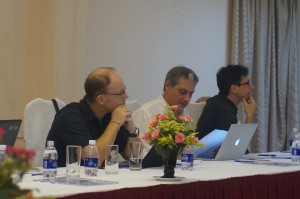The 2015 International Year of Soils is an occasion to celebrate and raise awareness of Earth’s soil and its functions for humanity. Soil organisms perform main soil functions such as OM degradation, plant’s nutrient, biological regulation and they are firstly impacted by the intensity of agricultural practices. Our meeting objective will address the question of how these agricultural practices in South East Asia modify the soil leaving assemblages (microorganisms, nematodes and soil fauna). By targeting soil nematofauna and microbial communities, we will present results showing the impact of field management on microbial and nematode communities’ organization in different agricultural systems. In a context where international grants tend towards global projects, SunRise (Surveillance Network on Rice Health in South East Asia) offers the opportunity to scientists with regional specificities to get together and share their knowledge and recent work, thus reinforcing the international network initiated in 2013 and facilitating applications for funds to support their research activities. The “2nd SUNRISE MEETING: Soil management practices and incidence on microbial and nematode communities” is taking place on October 5th-6th in Hanoi, to respond to such a context and as a result of the joint effort from IRD, SELTAR and LMI Rice.

Participants are from various research institutions in Southeast Asia and elsewhere, such as IRD, CIAT, CIRAD, VAST, Cambodia, the Philippines, Thailand, Belgium, South Africa, Myanmar etc, who all share the same interest in soils management, as well as how to improve the SUNRISE community and find grants for research and animation. The agenda of the meeting can be found here: Programme Sunrise meeting. LMI Rice (International Joint Laboratory focused on Rice Functional Genomics and Plant Biotechnology https://sites.google.com/site/lmiricevn/home) was created by the Institute of Genetic Agronomy of Hanoi (IAG), belonging to the Vietnam Academy of Agricultural Science (VAAS) in association with the Joint Research Unit Diversité, Adaptation et Développement des Plantes (UMR DIADE, IRD/UM2) and the University of Science and Technology of Hanoi (USTH).



